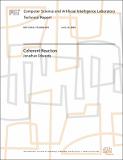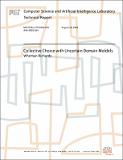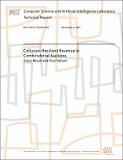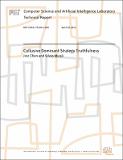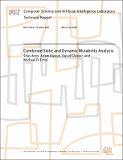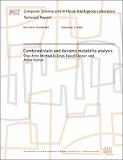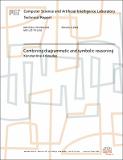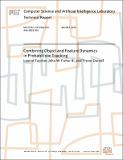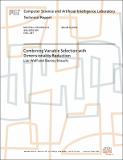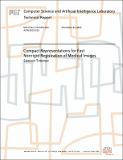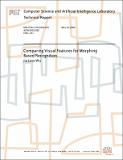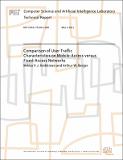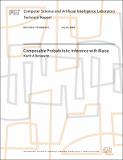Browsing CSAIL Technical Reports (July 1, 2003 - present) by Title
Now showing items 143-162 of 775
-
Coherent Reaction
(2009-06-12)Side effects are both the essence and bane of imperative programming. The programmer must carefully coordinate actions to manage their side effects upon each other. Such coordination is complex, error-prone, and fragile. ... -
Collaborative Diagnosis of Over-Subscribed Temporal Plans
(2016-10-14)Over-subscription, that is, being assigned too many tasks or requirements that are too demanding, is commonly encountered in temporal planning problems. As human beings, we often want to do more than we can, ask for things ... -
Collective Choice with Uncertain Domain Moldels
(2005-08-16)When groups of individuals make choices among several alternatives, the most compelling social outcome is the Condorcet winner, namely the alternative beating all others in a pair-wise contest. Obviously the Condorcet ... -
Collusion-Resilient Revenue In Combinatorial Auctions
(2007-11-02)In auctions of a single good, the second-price mechanism achieves, in dominantstrategies, a revenue benchmark that is naturally high and resilient to anypossible collusion.We show how to achieve, to the maximum extent ... -
Collusive Dominant-Strategy Truthfulness
(2011-04-22)Fifty years ago, Vickrey published his famous mechanism for auctioning a single good in limited supply. The main property of Vickrey's mechanism is efficiency in dominant strategies. In absence of collusion, this is a ... -
Combined Static and Dynamic Mutability Analysis
(2007-03-23)Knowing which method parameters may be mutated during a method's execution is useful for many software engineering tasks. We present an approach to discovering parameter immutability, in which several lightweight, scalable ... -
Combined static and dynamic mutability analysis
(2006-09-17)Knowing which method parameters may be mutated during a method'sexecution is useful for many software engineering tasks. We presentan approach to discovering parameter immutability, in which severallightweight, scalable ... -
Combining diagrammatic and symbolic reasoning
(2005-10-06)We introduce a domain-independent framework for heterogeneous natural deduction that combines diagrammatic and sentential reasoning. The framework is presented in the form of a family of denotational proof languages (DPLs). ... -
Combining dynamic abstractions in large MDPs
(2004-10-21)One of the reasons that it is difficult to plan and act in real-worlddomains is that they are very large. Existing research generallydeals with the large domain size using a static representation andexploiting a single ... -
Combining Object and Feature Dynamics in Probabilistic Tracking
(2005-03-02)Objects can exhibit different dynamics at different scales, a property that isoftenexploited by visual tracking algorithms. A local dynamicmodel is typically used to extract image features that are then used as inputsto a ... -
Combining Variable Selection with Dimensionality Reduction
(2005-03-30)This paper bridges the gap between variable selection methods (e.g., Pearson coefficients, KS test) and dimensionality reductionalgorithms (e.g., PCA, LDA). Variable selection algorithms encounter difficulties dealing with ... -
Compact Representations for Fast Nonrigid Registration of Medical Images
(2003-07-04)We develop efficient techniques for the non-rigid registration of medical images by using representations that adapt to the anatomy found in such images. Images of anatomical structures typically have uniform intensity ... -
Comparing Network Coding with Multicommodity Flow for the k-pairs Communication Problem
(2004-11-24)Given a graph G = (V,E) and k source-sink pairs of vertices, this papers investigates the maximum rate r at which all pairs can simultaneously communicate. We view this problem from two perspectives and compare their ... -
Comparing Visual Features for Morphing Based Recognition
(2005-05-25)This thesis presents a method of object classification using the idea of deformable shape matching. Three types of visual features, geometric blur, C1 and SIFT, are used to generate feature descriptors. These feature ... -
A Comparison of Autonomic Decision Making Techniques
(2011-04-01)Autonomic computing systems are capable of adapting their behavior and resources thousands of times a second to automatically decide the best way to accomplish a given goal despite changing environmental conditions and ... -
Comparison of User Traffic Characteristics on Mobile-Access versus Fixed-Access Networks
(2011-05-03)We compare Web traffic characteristics of mobile- versus fixed-access end-hosts, where herein the term "mobile" refers to access via cell towers, using for example the 3G/UMTS standard, and the term "fixed" includes Wi-Fi ... -
Complexity of finding Nash equilibria in 0-1 bimatrix games
(2005-02-08)We exhibit a polynomial reduction from the problem of finding a Nashequilibrium of a bimatrix game with rational coefficients to the problemof finding a Nash equilibrium of a bimatrix game with 0-1 coefficients. -
Component based recognition of objects in an office environment
(2003-11-28)We present a component-based approach for recognizing objectsunder large pose changes. From a set of training images of a givenobject we extract a large number of components which are clusteredbased on the similarity of ... -
Composable Probabilistic Inference with Blaise
(2008-07-23)Probabilistic inference provides a unified, systematic framework for specifying and solving these problems. Recent work has demonstrated the great value of probabilistic models defined over complex, structured domains. ... -
Compositional Policy Priors
(2013-04-12)This paper describes a probabilistic framework for incorporating structured inductive biases into reinforcement learning. These inductive biases arise from policy priors, probability distributions over optimal policies. ...

